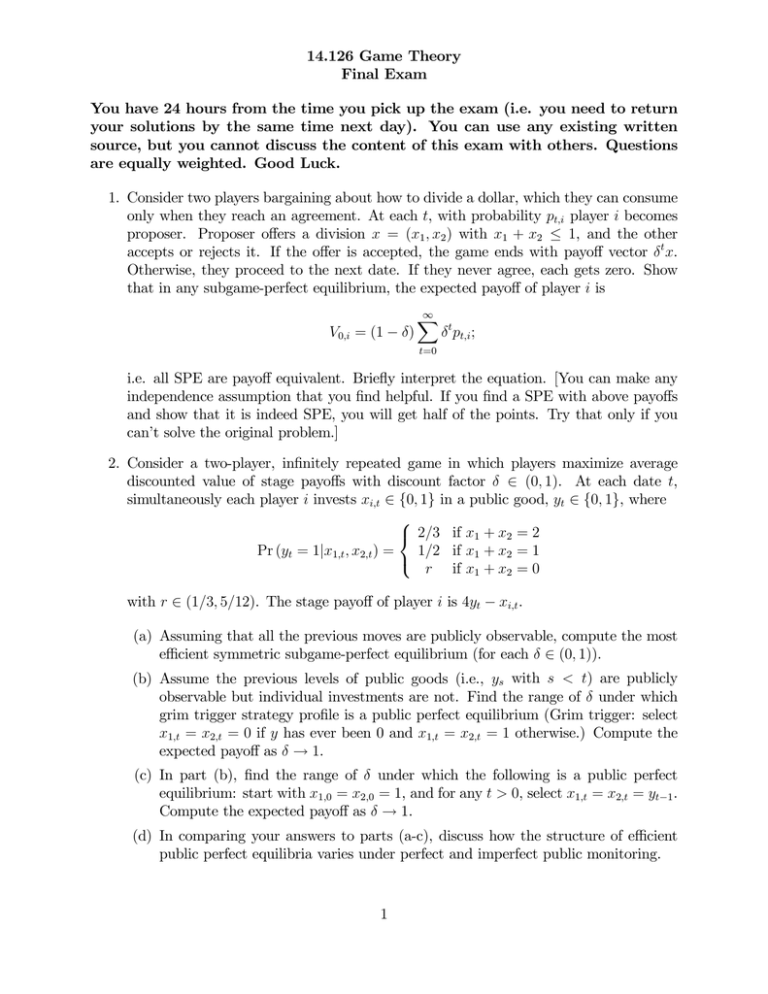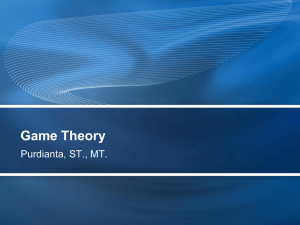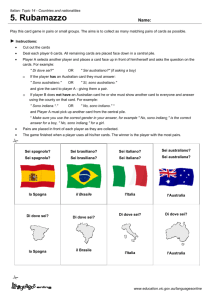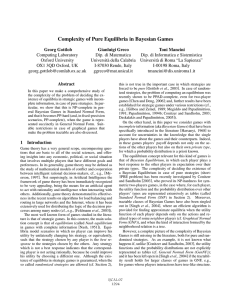Esame Finale Teoria dei Giochi - MIT 14.126
advertisement

14.126 Game Theory
Final Exam
You have 24 hours from the time you pick up the exam (i.e. you need to return
your solutions by the same time next day). You can use any existing written
source, but you cannot discuss the content of this exam with others. Questions
are equally weighted. Good Luck.
1. Consider two players bargaining about how to divide a dollar, which they can consume
only when they reach an agreement. At each t, with probability pt,i player i becomes
proposer. Proposer offers a division x = (x1 , x2 ) with x1 + x2 ≤ 1, and the other
accepts or rejects it. If the offer is accepted, the game ends with payoff vector δ t x.
Otherwise, they proceed to the next date. If they never agree, each gets zero. Show
that in any subgame-perfect equilibrium, the expected payoff of player i is
V0,i = (1 − δ)
∞
X
δt pt,i ;
t=0
i.e. all SPE are payoff equivalent. Briefly interpret the equation. [You can make any
independence assumption that you find helpful. If you find a SPE with above payoffs
and show that it is indeed SPE, you will get half of the points. Try that only if you
can’t solve the original problem.]
2. Consider a two-player, infinitely repeated game in which players maximize average
discounted value of stage payoffs with discount factor δ ∈ (0, 1). At each date t,
simultaneously each player i invests xi,t ∈ {0, 1} in a public good, yt ∈ {0, 1}, where
⎧
⎨ 2/3 if x1 + x2 = 2
1/2 if x1 + x2 = 1
Pr (yt = 1|x1,t , x2,t ) =
⎩
r if x1 + x2 = 0
with r ∈ (1/3, 5/12). The stage payoff of player i is 4yt − xi,t .
(a) Assuming that all the previous moves are publicly observable, compute the most
efficient symmetric subgame-perfect equilibrium (for each δ ∈ (0, 1)).
(b) Assume the previous levels of public goods (i.e., ys with s < t) are publicly
observable but individual investments are not. Find the range of δ under which
grim trigger strategy profile is a public perfect equilibrium (Grim trigger: select
x1,t = x2,t = 0 if y has ever been 0 and x1,t = x2,t = 1 otherwise.) Compute the
expected payoff as δ → 1.
(c) In part (b), find the range of δ under which the following is a public perfect
equilibrium: start with x1,0 = x2,0 = 1, and for any t > 0, select x1,t = x2,t = yt−1 .
Compute the expected payoff as δ → 1.
(d) In comparing your answers to parts (a-c), discuss how the structure of efficient
public perfect equilibria varies under perfect and imperfect public monitoring.
1
3. Consider the differentiated Bertrand duopoly. Each firm i has a cost ci , and the firms
set the prices p1 ∈ [c1 , p̄] and p2 ∈ [c2 , p̄] simultaneously, where p̄ is a large number.
The demand for the product of firm i is Di (p1 , p2 , θ) where θ is a commonly known
demand parameter, Di is continuous, supermodular, decreasing in the price pi of firm’s
own price, and increasing in the other firm’s price and θ. The profit of firm i is
Di (p1 , p2 , θ) (pi − ci ) .
[You can make any convenient differentiability assumption.]
c2 common knowledge, show that there exist pure strategy
(a) Assuming that c³1 and ´
Nash equilibria p1 , p2 and (p̄1 , p̄2 ) such that for each rationalizable strategy pi ,
pi ≤ pi ≤ p̄i .
(b) In part (a), show that pi and p̄i are weakly increasing in θ.
(c) Assume that for each i, ci is a privately known by i and it is a rational number in
[0, p̄]. Under this assumption, state analogous results to the ones in parts (a) and
(b), and prove them. [Hint: since ci is restricted to be rational, you don’t need
to worry about completeness.]
4. Modify the stage game in question 2, defining
⎧
⎨ p if x1 + x2 = 2
q if x1 + x2 = 1
Pr (y = 1|x1 , x2 ) =
⎩
r if x1 + x2 = 0
where p > q > r and p − q > q − r, and taking the payoff of player i to be θy − xi .
The unknown parameter θ is exponentially distributed with parameter λ > 0. Each
player i observes a signal si = θ + εη i , where ε is a real number and η i is uniformly
distributed on [−1, 1]. Assume that (θ, η 1 , η 2 ) are independent. Show that there exists
ε̄ > 0 such that for any ε ∈ (0, ε̄), the game is "dominance solvable", and compute the
"unique" equilibrium strategy.
2
MIT OpenCourseWare
http://ocw.mit.edu
14.126 Game Theory
Spring 2010
For information about citing these materials or our Terms of Use, visit: http://ocw.mit.edu/terms.



